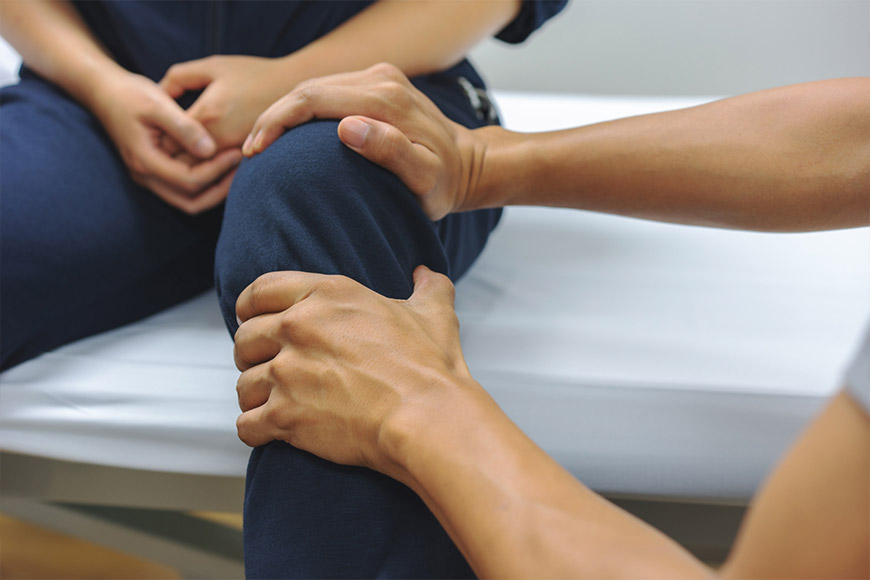
Physical therapy and knee treatment
Physical therapy and knee treatment, Belgrade. TOP PRICE✓ Treatment: Arthrosis, arthritis, crepitations, gonarthrosis, inflammation. Shockwave, laser, cryotherapy, electrotherapy✓
Physical therapy and knee treatment
The knee is an extremely complex joint, and knee injuries often occur due to sports activities or years of strain. Injuries to the anatomical structures that make up the knee require mandatory medical examination, and physical therapy for knee injuries is often recommended.
Common Causes of Knee Injury
Knee pain during movement can be categorized into acute pain resulting from trauma and chronic pain caused by other severe diseases and overuse. During a knee injury, additional damage may occur to its surrounding tissues, nerve fibers, blood vessels, and soft tissues.
Running, long walks, and weight lifting can lead to microtrauma to sensitive parts of the knee. Due to the strain, inflammation and irritation of various joint structures can occur. One type of inflammation is bursitis, affecting the periarticular cavities filled with fluid, while tendovaginitis arises from changes in tendons and their sheaths.
Common issues include nerve impingement and knee instability, as well as thickening of joint ligaments and changes in the cartilage surfaces. Cases where knee pain is caused by an autoimmune process, where the immune system attacks the knee tissue, are also not uncommon.
Treatment and Pain Relief for Knee Injuries
Chronic knee pain during movement is a clear signal to visit a doctor, as early detection of the cause leads to more effective treatment. Otherwise, it may lead to severe knee injuries that are difficult to heal.
One of the first options is to use pain relief medications, but such therapy should not be considered a long-term solution, as it can seriously harm the stomach. A more effective method would be the use of a knee brace during walking, as it will prevent the joint from deviating from its normal position. Massage can help alleviate various types of nerve and tissue blockages, as well as strengthen the muscles.
There are methods used for restoring cartilage tissue in the knee and preventing its destruction, but these do not provide immediate results. It is a demanding process requiring patience over several months, during which therapy must be regularly applied. It is effective only in the early stages of the disease, when the cartilage is not completely destroyed.
Physical Therapy and Knee Recovery After Surgery
To preserve knee function, one of the most important joints, surgical intervention may sometimes be unavoidable, after which physical therapy is recommended for recovery. Before surgery, it is crucial for the patient to be informed about exercises for the quadriceps and straight leg raises, as a trained muscle will return to normal function faster than an untrained one.
Knee Rehabilitation After Surgery
In the first days after surgery, the patient begins to exercise to increase mobility without risking any problems with wound healing, as strong synthetic threads are used during the surgical process.
During hospital stay, doctors strive for the patient to achieve active terminal knee extension by exercising the quadriceps in small arcs, to make the knee as functional as possible. After an average of two weeks, stitches are removed, and the patient can transition to hydrotherapy and mobility-enhancing exercises.
Cybex Therapy for Knee Treatment
For the Cybex machine, which provides the best possible progress, knee mobility of 70 to 90 degrees is required. If the patient's mobility is less, the machine can be blocked by placing a chair under the feet to ensure that the range of exercises and movements is comfortable and not injurious. During this period, doctors closely monitor to prevent increased knee swelling.
At the beginning of physical therapy, the patient visits five times a week, later transitioning to exercises three times a week. When achieving mobility of 110 degrees, the patient is ready for exercises on a standard bicycle, and after three to six weeks, exercises can be continued at home using weights or on a Nautilus machine.
Knee Physical Therapy for Athletes
For athletes, knee injury can be a serious issue that limits their participation in running sports, such as soccer. After surgery, the patient will be unable to run backward or engage in sports as they did before. In such cases, the best solution is to use a knee brace that will provide support to the muscles during exercise.
Using a Cybex machine, a precise measurement of muscle strength can be performed, and the patient is not allowed to engage in sports until they achieve at least 90 percent muscle strength compared to the healthy leg.
After a knee injury, it is important to rehabilitate not only the muscles within the knee but also the hip flexors, extensors, abductors, and the gastrocnemius. A stretching program for the quadriceps and hamstrings is a vital part of knee care before and after the injury.
Prevention through exercises and reducing strain is the best method to adhere to in order to avoid future knee problems. If you need assistance, Eliksir Health Care is available with professional physical therapy services to help you recover and heal as quickly as possible.
How to Contact Us?
For more information about our services or if you have any questions, feel free to visit our CONTACT page and get in touch with us. We’re here to help!